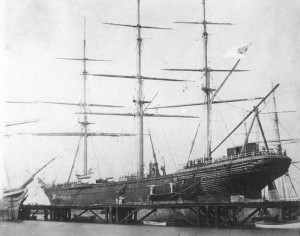Good morning, Whitewater.
Sunday in town will be partly cloudy, with a high of ninety, and strong scattered thunderstorms in the late afternoon.
When a bison at a national park attacks a tourist, as happens now and again, whose fault is that? In the FW poll for Friday, 77.27% of respondents said the park visitors should be responsible, 18.18% said the park should be responsible, and 4.55% said the bison should be responsible. If it should be the bison’s responsibility, perhaps that leads to a recipe.
On this day in 1865, the crew of the Shenandoah finally accept news of the South’s surrender:
The captain and crew of the C.S.S. Shenandoah, still prowling the waters of the Pacific in search of Yankee whaling ships, is finally informed by a British vessel that the South has lost the war.
The Shenandoah was the last major Confederate cruiser to set sail. Launched as a British vessel in September 1863, it was purchased by the Confederates and commissioned in October 1864. The 230-foot-long craft was armed with eight large guns and a crew of 73 sailors. Commanded by Captain James I. Waddell, theShenandoah steered toward the Pacific and targeted Yankee whaling ships. Waddell enjoyed great success, taking six ships in the South Pacific before slipping into Melbourne, Australia, for repairs in January 1865.
Within a month, the Shenandoah was back on the loose, wreaking havoc in the waters around Alaska. The Rebel ship captured 32 additional Union vessels, most of which were burned. The damage was estimated at $1.6 million, a staggering figure in such a short period of time. Although the crew heard rumors that the Confederate armies had surrendered, Waddell continued to fight. He finally accepted an English captain’s report on August 2, 1865. The Shenandoah pulled off another remarkable feat by sailing from the northern Pacific all the way to Liverpool, England, without stopping at any ports. Arriving on November 6, Waddell surrendered his ship to British officials.

Plaster life cast of Black Hawk, original ca. 1830, at Black Hawk State Historic Site. Via Wikipedia.
On this day in 1832, war in the Midwest ends:
1832 – Black Hawk War Ends
On this date the defeat of Black Hawk and his followers at the Battle of Bad Axe, ended the Black Hawk War. Black Hawk led the American troops northward while the rest of the Indians constructed rafts and canoes to facilitate an escape over the Mississippi river. The plan was successful initially but eventually General Atkinson realized the ruse. In the battle, women, children and the elderly hid behind rocks and logs and American soldiers often could not or did not differentiate between warriors and the women and children. Atkinson sent Wabasha and his Sioux warriors, enemies of the Sauk, after the approximately 150 members of the British Band that made it to the Western bank of the Mississippi. The Sauk, “escaped the best they could, and dispersed“, but only 22 women and childern were spared. Black Hawk escaped, but the Battle of Bad Axe marked the end of the war. [Source: Along the Black Hawk Trail by William F. Stark, p.142-153]

